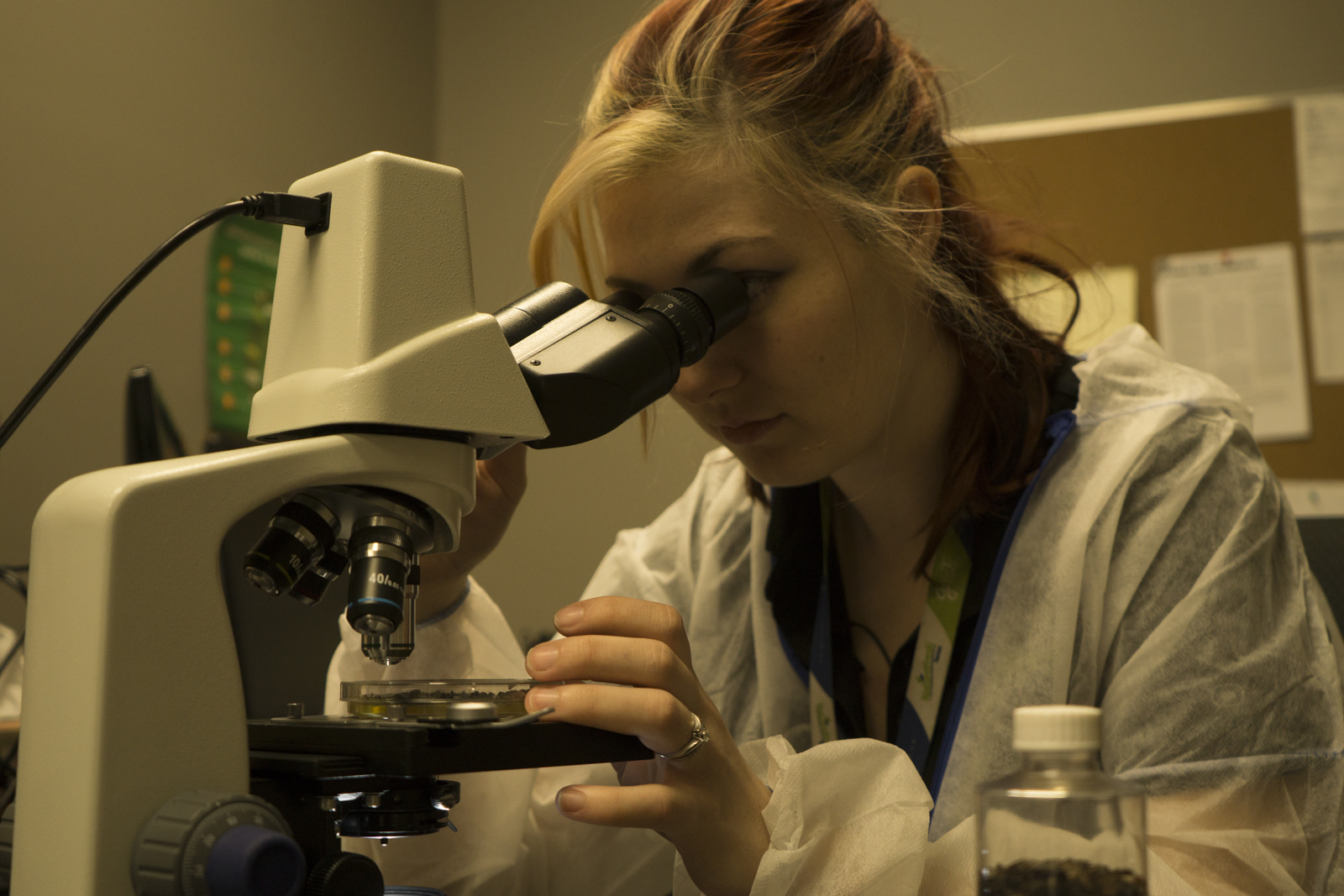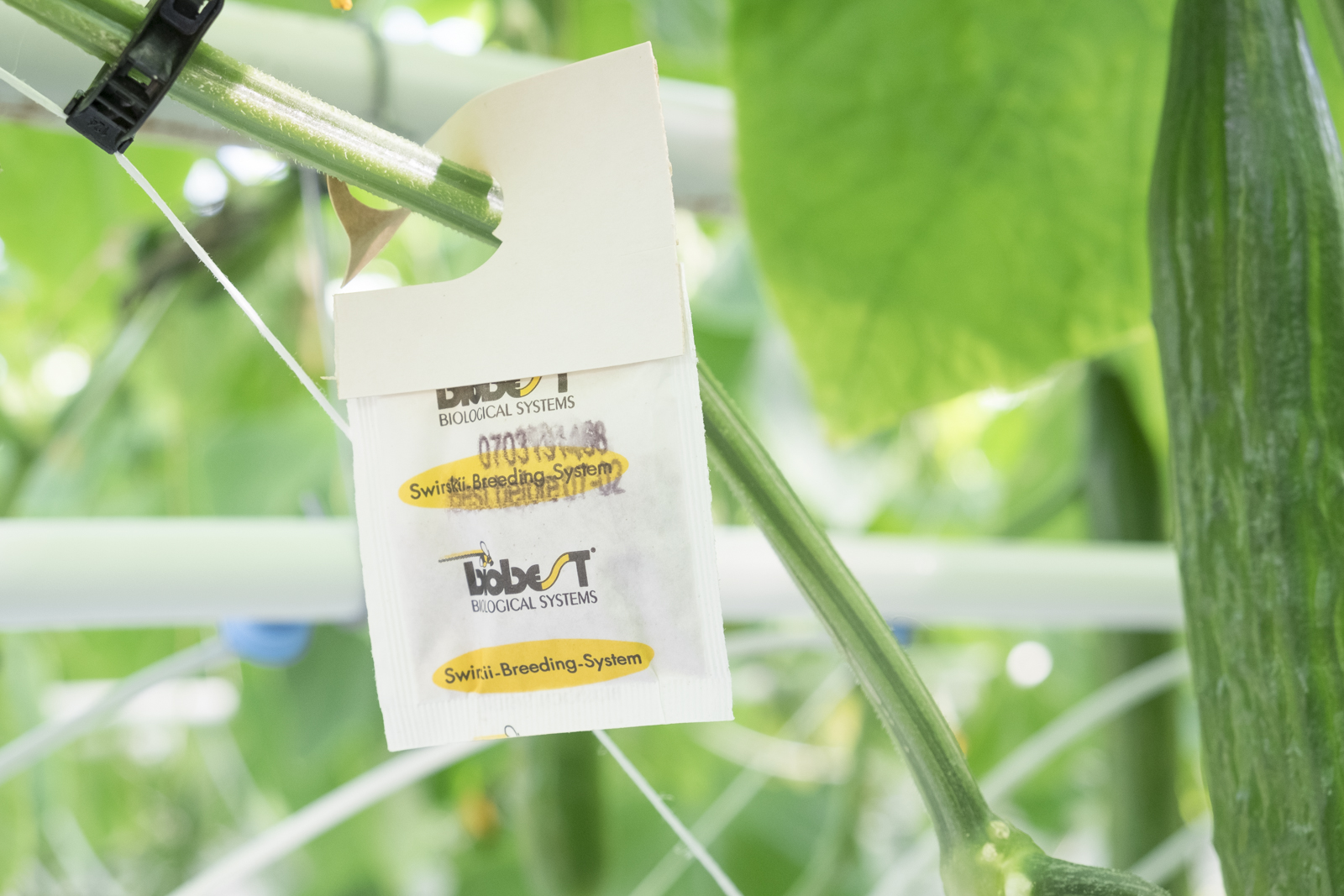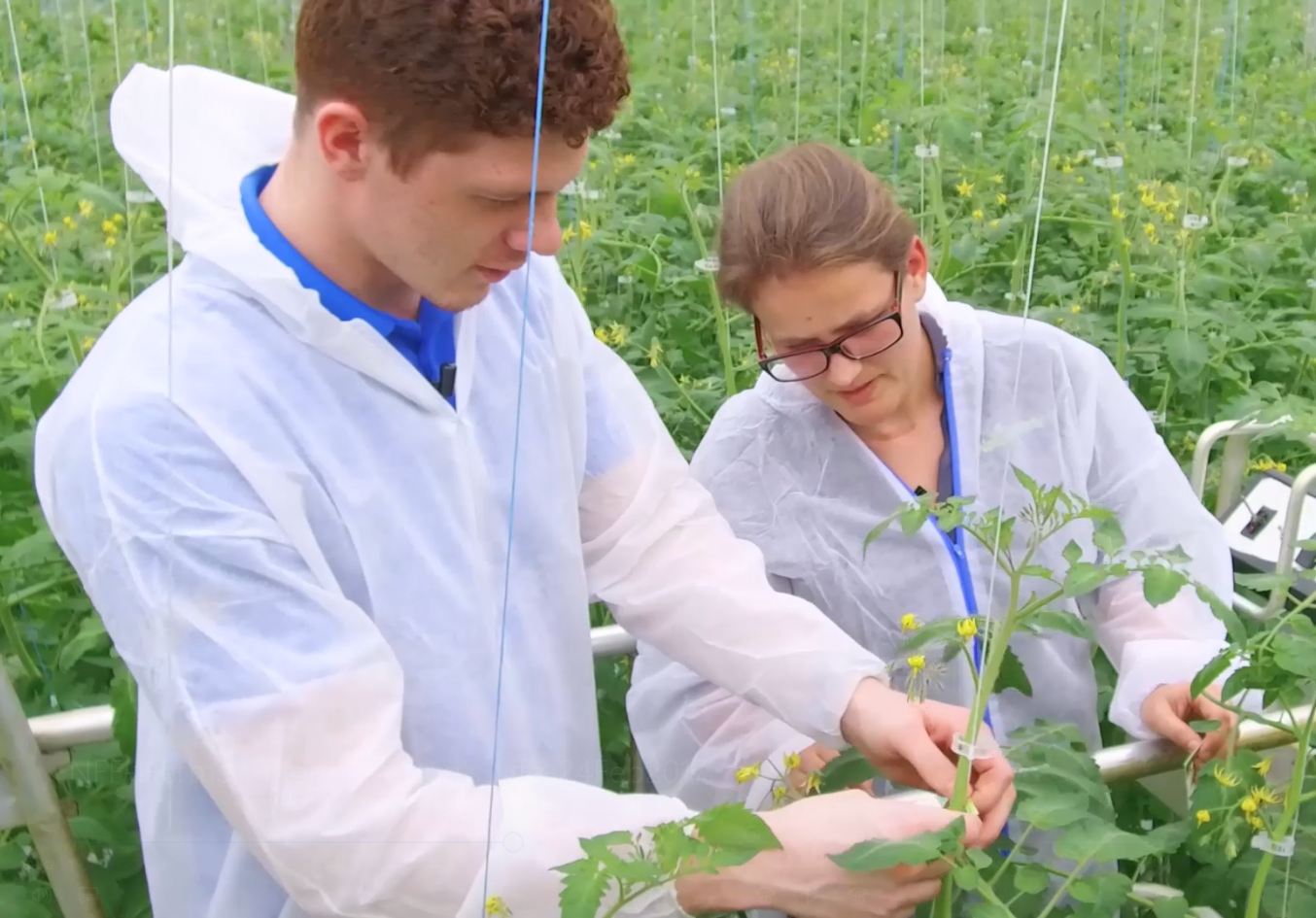Good bugs vs the bad bugs, is there really that much of a difference? Bugs are all around us, especially in a NatureFreshTM greenhouse. Let me clarify, good bugs are all around us, not the creepy crawlers you might be thinking of but our Beneficial Bios. Taking a stroll through our greenhouse, you’ll find a variety of different species of beneficial bios, 19 native species to be exact. They all play a vital role in keeping our plants safe; whether they’re the silent but deadly type or the mighty gladiator, as long as they prey on pests, they have an all access pass to NatureFreshTM.
The process of introducing good bugs to fight bad bugs is called an Integrated Pest Management (IPM) system. This system involves trained Scouts, also known as the #BugBrigade, who examine our crops on a daily basis in search of any pests or diseases that can harm our crops. These Scouts will then consult with our IPM Leads to determine the best preventative measures to ensure we don’t have any major pest or disease outbreaks. It’s a team effort that is executed with the help of our preventative bios.
 Scouts are vital to NatureFreshTM Farms’ hands on approach to growing, as they are continuously monitoring our entire crop to ensure all is well. At NatureFreshTM, we have 7 scouts that will inspect their respective range weekly: Tina H., Melissa P., Helen H., Susie F., Michael M., Julian B. and Mary T. We also have our IPM Lead Tina F. and IPM Manager Cam L. who both monitor data provided by the scouts and determine the best solution to any potential concerns.
Scouts are vital to NatureFreshTM Farms’ hands on approach to growing, as they are continuously monitoring our entire crop to ensure all is well. At NatureFreshTM, we have 7 scouts that will inspect their respective range weekly: Tina H., Melissa P., Helen H., Susie F., Michael M., Julian B. and Mary T. We also have our IPM Lead Tina F. and IPM Manager Cam L. who both monitor data provided by the scouts and determine the best solution to any potential concerns.
By mid-season, our scouts could tell you when and where a leaf fell off a plant; they’re completely in sync with the crop. To ensure I properly represent all that is IPM, I visited with Tina H. and Tina F. to give me more insight on what the method to the madness is.
My first question was, why would we intentionally introduce a diverse group of predatorial insects into our greenhouse? Tina H. immediately responded, “Reducing the use of pesticides is a priority and our bios give us the power to do this.” Bios will reduce or eliminate our pest populations by feeding on them in a variety of different fashions; they are quite creative with their eating habits. Some have bigger appetites, some like to relax during periods of time during the growing season and some focus on different pests. This is why we must introduce a variety of good bugs in order to maintain a defense system for our crop; they all serve a unique purpose and when you combine them, you get the equivalent of a lethal utility knife.
 Who are these mysterious creatures that do all these great things for us? You may have already met a few in the past. A bio that we always welcome into our greenhouse is the common Ladybug, also known as ‘Hippodamia Convergens’. Ladybugs are great for pest management because they will eat nearly every soft bodied insect in sight. Their favorite meal? Aphids. Aphids are a common pest which many gardeners are far too familiar with. We are susceptible to Aphids as well, however, because we have our preventative bios in place, I like our odds against the Aphids.
Who are these mysterious creatures that do all these great things for us? You may have already met a few in the past. A bio that we always welcome into our greenhouse is the common Ladybug, also known as ‘Hippodamia Convergens’. Ladybugs are great for pest management because they will eat nearly every soft bodied insect in sight. Their favorite meal? Aphids. Aphids are a common pest which many gardeners are far too familiar with. We are susceptible to Aphids as well, however, because we have our preventative bios in place, I like our odds against the Aphids.
My personal favorite beneficial bio is the Lacewing. This beautiful insect has a dark side, it’s a vicious predator that attacks its prey from above; the Aphids don’t know what hit them. There’s also Persimilis which is a microscopic bio that lacks size but makes up for it in aggression. These little guys will target Spider Mite, a harmful microscopic pest that will suffocate the head of a plant and stunt its growth. Our beneficial bios come in all shapes and sizes, but they all contribute to the battle against pests in their own way.
 We have a diverse group of beneficial bios and we release them in a variety of different ways. Some are simply hand released from a container of some sort like our Ladybugs. You can also create a slow release system which consists of a sachet with up to 1 000 microscopic bios and feeder mite inside that the bios will feed on. Because the bios have a food source, they will take their time to leave the comfort of their sachet.
We have a diverse group of beneficial bios and we release them in a variety of different ways. Some are simply hand released from a container of some sort like our Ladybugs. You can also create a slow release system which consists of a sachet with up to 1 000 microscopic bios and feeder mite inside that the bios will feed on. Because the bios have a food source, they will take their time to leave the comfort of their sachet.
 Our Bug Brigade doesn’t rely solely on our good bugs to reduce pest populations, which is why every year, sticky cards or tape are placed around the greenhouse to attract and catch pests. One sticky card can catch up to 8 000 pests! The physical barrier of the greenhouse also reduces the risk of pest outbreak, but any pest that dares to enter the greenhouse will likely be taken care of swiftly by our preventative measures that we have put in place.
Our Bug Brigade doesn’t rely solely on our good bugs to reduce pest populations, which is why every year, sticky cards or tape are placed around the greenhouse to attract and catch pests. One sticky card can catch up to 8 000 pests! The physical barrier of the greenhouse also reduces the risk of pest outbreak, but any pest that dares to enter the greenhouse will likely be taken care of swiftly by our preventative measures that we have put in place.
There’s one more insect that you can find buzzing around our greenhouses, our Bumble Bees. While some say, bees shouldn’t be able to fly, we’re not worried about the physics behind what they do, we’re simply impressed by their tremendous work ethic. With over 100,000 bees in our Ontario greenhouses throughout the growing season, the bees have a very important job to execute on a daily basis: pollination. This is their sole purpose, they do not produce any honey, they simply transfer pollen and enjoy the beautiful weather in our controlled greenhouse environment. It’s like going on an all-inclusive vacation where you can do what you want when you want!
Tina F. gave me the run down of everything there is to know about these amazing creatures. NatureFreshTM Farms Bumble Bee of choice is the ‘Bombus Impatiens’, which is a native species to North America. Many ask the obvious question, why not use Honey Bees? Bumble Bees are much more efficient pollinators because of their fuzzy coats, their ability to buzz pollinate, and they’re much less aggressive. This is important because we allow all of our bees to roam freely in the crop and no crop worker wants to start the day with a bee sting. As long as a Bumble Bee has a food source, good weather, and a hive, they’re as happy as a bug in a rug!
When we receive the Bumble Bee hives from a local supplier, there are approximately 100 worker bees and of course 1 Queen Bee in each hive. Within a few months, their hive population can increase to 150 bees. This is a great indication that the bees are not only surviving, but thriving in their environment.
In our Tomato crop, we have roughly 40 hives per acre while a Bell Pepper crop will only have 1 hive per acre. This discrepancy is due to the fact that Bell Pepper plants can set fruit without the presence of bees while a Tomato plant requires a bee to agitate the flower in order to set fruit. No matter how you slice it, bees are crucial to the growing process and can often be overlooked; not today, today we salute the bees and the Grow-to People that ensure all is well in our bugs lives.



That is what it comes down to for our #BugBrigade, ensuring we have a solid population of good bugs to keep our crop healthy. By using an IPM program, we take a natural, hands on approach to growing which is what our plants deserve considering the great vegetables they produce. It’s the passion and hard work that our Grow-to People put into their craft that makes everything possible.
 Whether they’re putting out 350 000+ sachets of good bugs throughout the growing season, checking countless sticky cards or keeping a keen eye on the crop in search of any slight abnormality, our Bug Brigade is up for the task. It’s just what we do at NatureFreshTM Farms.
Whether they’re putting out 350 000+ sachets of good bugs throughout the growing season, checking countless sticky cards or keeping a keen eye on the crop in search of any slight abnormality, our Bug Brigade is up for the task. It’s just what we do at NatureFreshTM Farms.
For more information about our #BugBrigade, click here!
-Herman






